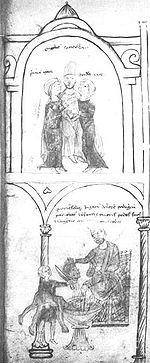- Matthew of Ajello
-
Matthew of Ajello[1] (Italian: Matteo d'Ajello) was a high-ranking member of the Norman court of the Kingdom of Sicily in the 12th century.
He first appears as the notary of the Admiral Maio of Bari who drew up the Treaty of Benevento of 1156. He rose to prominence in the next reign, that of William II of Sicily, becoming first grand protonotary and then chancellor.
Maio groomed Matthew to be his successor and, it was alleged, even used him to get permission from Pope Alexander III in Rome for Maio to succeed William I in 1159. On 10 November 1160, Matthew warned Maio of an impending assassination attempt, but to no avail. While Matthew escaped, Maio was killed by Matthew Bonnellus.
 From Peter of Eboli's Liber ad honorem Augusti of 1196. Matthew is depicted first with two wives and then bathing his feet in the blood of children.
From Peter of Eboli's Liber ad honorem Augusti of 1196. Matthew is depicted first with two wives and then bathing his feet in the blood of children.
In 1162, Matthew interceded to prevent the William I from sacking Salerno. On William's death, he became foremost among the advisors of the queen regent, Margaret of Navarre. After the rebellions of the later years of William's reign, Matthew compiled from memory a vast catalogue of records lost in the revolts. In 1166, he was a candidate for the chancellorship but was passed over in favour of Stephen du Perche, which caused him lasting resentment.
He took part in the conspiracies of Henry, Count of Montescaglioso, but was not arrested. However, he joined with Gentile, Bishop of Agrigento to assassinate Stephen in Palermo after Henry's arrest in Messina. This failed and both were arrested. Yet from prison Matthew coordinated a new conspiracy, and his plotters successfully besieged the chancellor in the cathedral tower and released Matthew, who offered the chancellor the opportunity to leave unmolested on crusade, paving the way for Matthew's own rise to the chancellery.
But Matthew was not raised immediately to the rank of chancellor. He was first appointed vice-chancellor (1169), in which capacity he constantly advised Margaret against interfering in the crisis between church and state in England, where Margaret supported Thomas Becket and Pope Alexander III, and Matthew firmly supported King Henry II, believing his cause was similar to that of the previous monarchs of Sicily. For similar reasons, in his later years he opposed Walter of the Mill's feudalising and pro-imperial policies. The chronicler Richard of San Germano described Walter and Matthew as "the two firmest columns of the Kingdom."
Though racked with gout, which the poet Peter of Eboli states he tried to cure by washing his feet in the blood of children, Matthew opposed the marriage of Constance, daughter of Roger II, to Henry VI and supported Tancred for the throne. It was Matthew's propaganda against Roger of Andria that ruined that claimant's candidature and secured Tancred's coronation and Matthew's urging that brought the Pope Clement III on side. For this, Tancred created Matthew chancellor, the first since the flight of Stephen du Perche in 1168.
Matthew's health, however, continued to deteriorate and he died at a great old age in 1193. He left as his monument a nunnery in Palermo named San Benedetto. He had two sons of influence: Richard, who was made count of Ajello (Calabria), and Nicholas, who was made archbishop of Salerno.
Notes
References
- Norwich, John Julius. The Kingdom in the Sun 1130-1194. Longman: London, 1970.
Categories:- 1193 deaths
- People from Salerno
- History of Sicily
Wikimedia Foundation. 2010.
